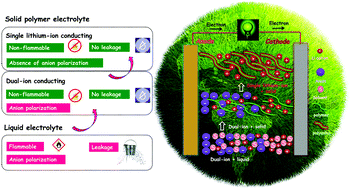Single lithium-ion conducting solid polymer electrolytes: advances and perspectives†
Abstract
Electrochemical energy storage is one of the main societal challenges to humankind in this century. The performances of classical Li-ion batteries (LIBs) with non-aqueous liquid electrolytes have made great advances in the past two decades, but the intrinsic instability of liquid electrolytes results in safety issues, and the energy density of the state-of-the-art LIBs cannot satisfy the practical requirement. Therefore, rechargeable lithium metal batteries (LMBs) have been intensively investigated considering the high theoretical capacity of lithium metal and its low negative potential. However, the progress in the field of non-aqueous liquid electrolytes for LMBs has been sluggish, with several seemingly insurmountable barriers, including dendritic Li growth and rapid capacity fading. Solid polymer electrolytes (SPEs) offer a perfect solution to these safety concerns and to the enhancement of energy density. Traditional SPEs are dual-ion conductors, in which both cations and anions are mobile and will cause a concentration polarization thus leading to poor performances of both LIBs and LMBs. Single lithium-ion (Li-ion) conducting solid polymer electrolytes (SLIC-SPEs), which have anions covalently bonded to the polymer, inorganic backbone, or immobilized by anion acceptors, are generally accepted to have advantages over conventional dual-ion conducting SPEs for application in LMBs. A high Li-ion transference number (LTN), the absence of the detrimental effect of anion polarization, and the low rate of Li dendrite growth are examples of benefits of SLIC-SPEs. To date, many types of SLIC-SPEs have been reported, including those based on organic polymers, organic–inorganic hybrid polymers and anion acceptors. In this review, a brief overview of synthetic strategies on how to realize SLIC-SPEs is given. The fundamental physical and electrochemical properties of SLIC-SPEs prepared by different methods are discussed in detail. In particular, special attention is paid to the SLIC-SPEs with high ionic conductivity and high LTN. Finally, perspectives on the main challenges and focus on the future research are also presented.



 Please wait while we load your content...
Please wait while we load your content...